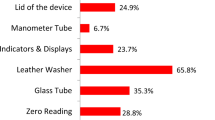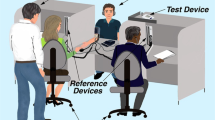Abstract
Accurate blood pressure (BP) measurement is dependent on a trained observer using validated and properly maintained equipment. BP devices should be checked regularly to ensure that their calibration remains within the European Standard specification of ±3 mm Hg. This study assessed the air leakage rates and calibration accuracy of BP devices in use at a large teaching hospital, using a calibrated electronic pressure gauge as reference. Air leakage rates were recorded over 1 min and static pressures were recorded at 250/200/150/100/50/0 mm Hg for computer download and analysis. A total of 127 devices were assessed (18 mercury, 62 aneroid and 47 automated). In total, 22 different models of devices were available, of which 11 were automated and only 4 had published evidence of a validation using a recognized protocol (British Hypertension Society, Association for the Advancement of Medical Instrumentation or International Protocol). Only 3% (n=4) of devices had an air leakage rate within 4 mm Hg per min and 25% (n=32) of devices failed to meet the European calibration standard of ±3 mm Hg. Respective failure rates were 6% (1/18) for mercury, 31% (19/62) for aneroid and 26% (12/47) for automated devices. Inaccurate BP measurement of only 3 mm Hg can have detrimental effects in the patient. This study shows a quarter of devices currently in use at a large teaching hospital to have an unacceptable calibration error. Regular maintenance and calibration checks are vital in ensuring that BP is measured as accurately as possible.
This is a preview of subscription content, access via your institution
Access options
Subscribe to this journal
Receive 12 digital issues and online access to articles
$119.00 per year
only $9.92 per issue
Buy this article
- Purchase on Springer Link
- Instant access to full article PDF
Prices may be subject to local taxes which are calculated during checkout


Similar content being viewed by others

References
European Society of Hypertension-European Society of Cardiology Guidelines Committee. 2003 European Society of Hypertension-European Society of Cardiology guidelines for the management of arterial hypertension. J Hypertens 2003; 21 (6): 1011–1053.
Chobanian AV, Bakris GL, Black HR, Cushman WC, Green LA, Izzo Jr JL et al. The Seventh Report of the Joint National Committee on prevention, detection, evaluation, and treatment of high blood pressure: the JNC 7 report. JAMA 2003; 289 (19): 2560–2572.
Commission of the European Communities. Communication from the Commission to the Council and the European Parliament: Community Strategy Concerning Mercury. 28 January 2005, Brussels. (http://eur-lex.europa.eu/LexUriServ/site/en/com/2005/com2005_0020en01.pdf).
O’Brien E, Petrie J, Littler W, de Swiet M, Padfield PL, Altman DG et al. The British Hypertension Society protocol for the evaluation of blood pressure measuring devices. J Hypertens 1993; 11 (Suppl 2): S43–S62.
O’Brien E, Pickering T, Asmar R, Myers M, Parati G, Staessen J et al. Working Group on Blood Pressure Monitoring of the European Society of Hypertension International Protocol for validation of blood pressure measuring devices in adults. Blood Press Monit 2002; 7 (1): 3–17.
European Standard EN 1060-1:1996. Specification for non-invasive sphygmomanometers. Part 1: General requirements. European Commission for Standardisation. Rue Stassart 36, B-1050, Brussels, 1996.
Turner MJ, Irwig L, Bune AJ, Kam PC, Baker AB . Lack of sphygmomanometer calibration causes over- and under-detection of hypertension: a computer simulation study. J Hypertens 2006; 24 (10): 1931–1938.
Ali S, Rouse A . Practice audits: reliability of sphygmomanometers and blood pressure recording bias. J Hum Hypertens 2002; 16 (5): 359–361.
Rouse A, Marshall T . The extent and implications of sphygmomanometer calibration error in primary care. J Hum Hypertens 2001; 15 (9): 587–591.
Knight T, Leech F, Jones A, Walker L, Wickramasinghe R, Angris S et al. Sphygmomanometers in use in general practice: an overlooked aspect of quality in patient care. J Hum Hypertens 2001; 15 (10): 681–684.
Coleman AJ, Steel SD, Ashworth M, Vowler SL, Shennan A . Accuracy of the pressure scale of sphygmomanometers in clinical use within primary care. Blood Press Monit 2005; 10 (4): 181–188.
Krass ME, LaBarber LP, Torres MA . Blood pressure measurement in family physician offices. Fam Med 1988; 20 (1): 25–27.
Canzanello VJ, Jensen PL, Schwartz GL . Are aneroid sphygmomanometers accurate in hospital and clinic settings? Arch Intern Med 2001; 161 (5): 729–731.
Markandu ND, Whitcher F, Arnold A, Carney C . The mercury sphygmomanometer should be abandoned before it is proscribed. J Hum Hypertens 2000; 14 (1): 31–36.
European Standard EN 1060-2:1996. Specification for non-invasive sphygmomanometers. Part 2 supplementary requirements for mechanical sphygmomanometers. European Commission for Standardisation. Rue Stassart 36, B-1050, Brussels, 1996.
The British Hypertension Society Website. 2008. Available at http://www.bhsoc.org/blood_pressure_list.stm (accessed on January 2009).
O’Brien E . A website for blood pressure measuring devices: dableducational.com. Blood Press Monit 2003; 8 (4): 177–180.
Anwar YA, Tendler BE, McCabe EJ, Mansoor GA, White WB . Evaluation of the Datascope Accutorr Plus according to the recommendations of the Association for the Advancement of Medical Instrumentation. Blood Press Monit 1997; 2 (2): 105–110.
Jones CR, Taylor K, Poston L, Shennan AH . Validation of the Welch Allyn ‘Vital Signs’ oscillometric blood pressure monitor. J Hum Hypertens 2001; 15 (3): 191–195.
Reinders A, Cuckson AC, Jones CR, Poet R, O’Sullivan G, Shennan AH . Validation of the Welch Allyn ‘Vital Signs’ blood pressure measurement device in pregnancy and pre-eclampsia. BJOG 2003; 110 (2): 134–138.
Topouchian JA, El Assaad MA, Orobinskaia LV, El Feghali RN, Asmar RG . Validation of two devices for self-measurement of brachial blood pressure according to the International Protocol of the European Society of Hypertension: the SEINEX SE-9400 and the Microlife BP 3AC1-1. Blood Press Monit 2005; 10 (6): 325–331.
Tholl U, Forstner K, Anlauf M . Measuring blood pressure: pitfalls and recommendations. Nephrol Dial Transplant 2004; 19 (4): 766–770.
Turner MJ, Baker AB, Kam PC . Effects of systematic errors in blood pressure measurements on the diagnosis of hypertension. Blood Press Monit 2004; 9 (5): 249–253.
Yarows SA, Qian K . Accuracy of aneroid sphygmomanometers in clinical usage: University of Michigan experience. Blood Press Monit 2001; 6 (2): 101–106.
Mion D, Pierin AM . How accurate are sphygmomanometers? J Hum Hypertens 1998; 12 (4): 245–248.
Bailey RH, Knaus VL, Bauer JH . Aneroid sphygmomanometers. An assessment of accuracy at a university hospital and clinics. Arch Intern Med 1991; 151 (7): 1409–1412.
Author information
Authors and Affiliations
Corresponding author
Rights and permissions
About this article
Cite this article
de Greeff, A., Lorde, I., Wilton, A. et al. Calibration accuracy of hospital-based non-invasive blood pressure measuring devices. J Hum Hypertens 24, 58–63 (2010). https://doi.org/10.1038/jhh.2009.29
Received:
Revised:
Accepted:
Published:
Issue Date:
DOI: https://doi.org/10.1038/jhh.2009.29
Keywords
This article is cited by
-
Accuracy of oscillometric-based blood pressure monitoring devices: impact of pulse volume, arrhythmia, and respiratory artifact
Journal of Human Hypertension (2023)
-
The urgency to regulate validation of automated blood pressure measuring devices: a policy statement and call to action from the world hypertension league
Journal of Human Hypertension (2022)
-
Results of a project to calibrate mercury sphygmomanometer blood pressure-measuring devices in Egypt
Journal of Human Hypertension (2021)
-
Challenges in standardization of blood pressure measurement at the population level
BMC Medical Research Methodology (2015)
-
Blood pressure differences between a mercury sphygmomanometer and two automatic devices
Biomedical Engineering Letters (2015)


